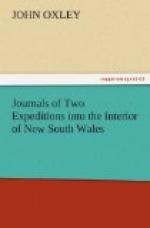June 12.—We this day passed over a very beautiful country, thinly wooded, and apparently safe from the highest floods; the river had considerable windings, but was of noble width and appearance; the rapids were few, and offered no obstruction; its medium width from one hundred and fifty to two hundred and fifty feet, and in many reaches much more. On one of the higher back ridges there are some good iron bark trees, with abundance of cypress; the apple, blue gum, and box, were the principal trees growing on the flats. Kangaroos were in very great numbers: our dogs took four; they were of that species called by Dr. Smith macropus elegans, and are very rare on the east coast. The stones and rocks were generally hard whinstone, or freestone, the former in large masses; the beach, of pebbles of all colours and kinds, from quartz to sandstone. About a mile from our resting-place, we passed the mouth of the small rivulet named in the former journey Elizabeth’s Burn; the stream now in it was inconsiderable.
June 13.—Our route during this day’s journey was generally over a very level country, the land three or four miles back from the river very inferior to that on the borders of it, being covered with small trees and brush; the soil a light, red loam. The rich flats on the banks on either side were not flooded, and were of the best quality: these flats seemed more extensive on the south than the north side of the river, and were bounded by the fine hills, which were passed over on the return of the expedition last year. About five miles from our last night’s resting-place, we fell in with a small rivulet from the north-east, which I named after Major Taylor, of the 48th regiment. On the west side of it, we came suddenly upon a couple of native families; they, however, with the exception of an old man, and a boy who was up a tree, made their escape. No entreaties could bring the boy down; he seemed, in fact, as well as the old man, petrified




